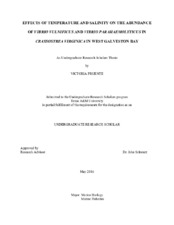| dc.creator | Pruente, Victoria L | |
| dc.date.accessioned | 2016-09-05T14:35:25Z | |
| dc.date.available | 2016-09-05T14:35:25Z | |
| dc.date.created | 2016-05 | |
| dc.date.issued | 2015-11-18 | |
| dc.date.submitted | May 2016 | |
| dc.identifier.uri | https://hdl.handle.net/1969.1/157645 | |
| dc.description.abstract | Vibrio vulnificus and Vibrio parahaemolyticus are potentially harmful pathogens that are naturally found in the estuarine environment. These pathogens commonly cause illness from the consumption of raw or undercooked oysters, which are known to concentrate bacteria through filter feeding. It is suspected that these species become more abundant as the water temperature increases, resulting in an increased potential for human infection. It is important to understand the relationship between abundance of the pathogen and water temperature and salinity for a specific region in order to prevent infection. In this study, the abundance of Vibrio spp. was quantified from weekly oyster samples from West Galveston Bay using quantitative PCR. The correlation tests and multiple linear regressions did not reveal any strong correlations between bacterial levels and environmental conditions. However, it was found that the levels of V. vulnificus and V. parahaemolyticus were found in greater levels when the water temperature and salinity were in the ideal ranges as stated in Givens et al. (2014). | en |
| dc.format.mimetype | application/pdf | |
| dc.subject | | en |
| dc.title | Effects of Temperature and Salinity on the Abundance of Vibrio vulnificus and Vibrio parahaemolyticus in Crassostrea virgnica in West Galveston Bay | en |
| dc.type | Thesis | en |
| thesis.degree.discipline | Marine Biology | en |
| thesis.degree.grantor | Undergraduate Research Scholars Program | en |
| dc.contributor.committeeMember | Schwarz, John | |
| dc.type.material | text | en |
| dc.date.updated | 2016-09-05T14:35:26Z | |


